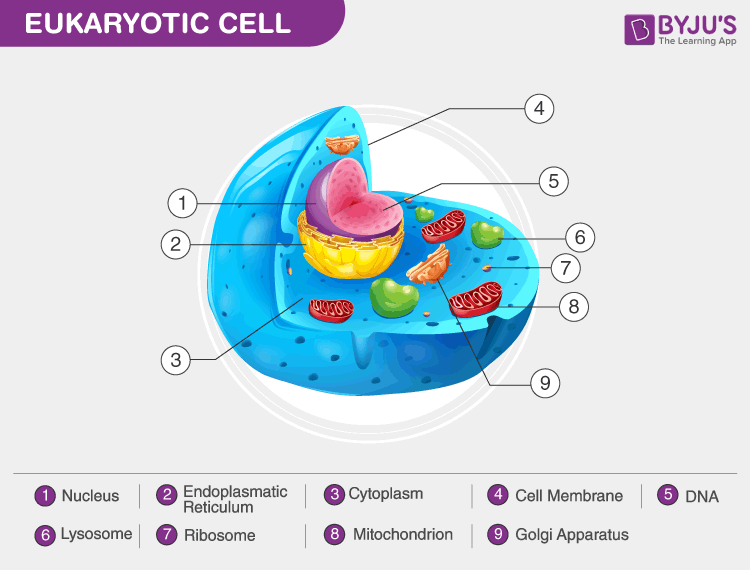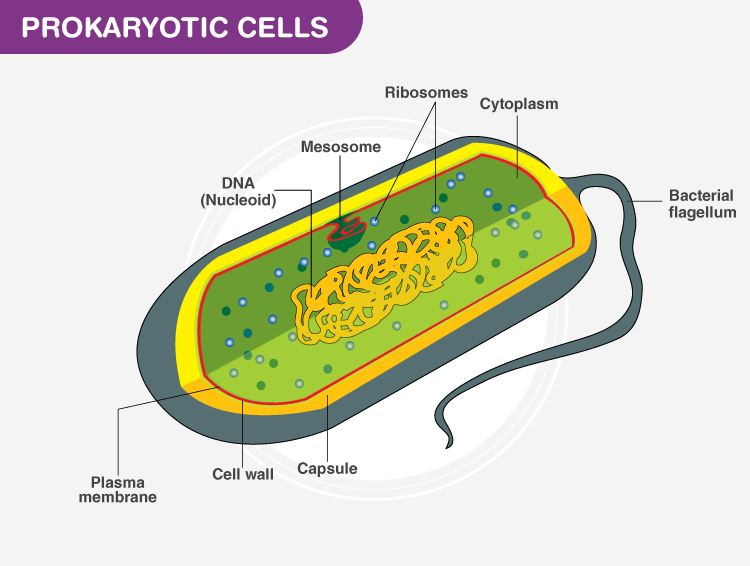Biology
>
GCSE
>
Cells and Control
>
difference...
differences between prokaryotic and eukaryotic cells
3 years ago
·
490 Replies
·
30353 views
Elizabeth Dempsey
490 Answers
Prokaryotic cells are simpler, smaller, and lack a nucleus.
Eukaryotic cells are more complex, with a nucleus and specialized organelles.
Both types contain ribosomes, cell membranes, and cytoplasm but differ in structure and complexity.
Eukaryotic have nuclues and membrane bound organelles. While prokaryotic do not have any of these.
Prokaryotic cells are smaller, simpler cells without a nucleus or membrane-bound organelles, and they typically reproduce through binary fission. Eukaryotic cells are larger, more complex, contain a nucleus, and have membrane-bound organelles like mitochondria and the Golgi apparatus. Examples of prokaryotes include bacteria, while eukaryotes include plants, animals, fungi, and protists.
Caring, supportive tutor with 17 years experience and 100% pass rate
1 reviews
Think of eukarytic cells (pronounced you-caryotic) as you cells, they belong to all animals and plants. Procaryotic cells belong to bacteria.
Your cells contain a cell surface membrane, a nucleus, mitochondria, golgi apparatus/body, lysosomes, ribosomes, rough endoplasmic reticulum (RER) and smooth endoplasmic reticulum (SER) as well as the cytoplasm.
Plants also have a cell wall, chloroplasts and a cell vacuole.
However Prokaryotic cells contain a cell plasma membrane, cytoplasm, they often have a cell wall, a capsule (the slime layer), circular DNA and plasmids as well as flagellum.
I'm available for 1:1 private online tuition!
Click here to view my profile and arrange a free introduction.Prokaryotic are always unicellular, while eukaryotic are usually multi-celled organisms.
Pharmacist student / science lover
1 reviews
Prokaryotic cells do not have a membrane and are always a part of unicellular organisms , whereas eukaryotic cells are membrane-bound organisms and are mutlicelluar.
I'm available for 1:1 private online tuition!
Click here to view my profile and arrange a free introduction.The main difference between prokaryotic and eukaryotic cells is that eukaryotic cells have membrane-bound organelles, meaning that their sub cellular components such as the mitochondria, and most importantly the nucleus (where the DNA is kept) are surrounded by an extra layer of protection known as a membrane.
In prokaryotic cells, all sub cellular structures are floating around in the cytoplasm, even the DNA; though the DNA is coiled up and mostly floats in an area of the cell known as the nucleoid.
There are some other major differences, such as prokaryotic are really small in comparison to eukaryotes, their chromosomes are circular and short, where as eukaryotes have linear and longer chromosomes and the type of ribosomes that they have are also different.
The difference between prokaryotic and eukaryotic cells can be defined this way,
- The prokaryotic cells lack a true nucleus, however a eukaryotic cell contains a true nucleus
- Examples; bacteria cell (prokaryote) vs animal/plant cell (eukaryote)
- Prokaryotic cells do contain genetic material however these are stored as free DNA/plasmids
Eukaryotic cells are cells like animal or plant cells.
prokaryotic cells are cells like bacteria.
The key difference between the two is that Eukaryotic cells contain membrane bound organelles whereas prokaryotic cells do not. They also have variable (different) organelles, for example eukaryotic cells have a nucleus whereas prokaryotic cells do not!
Qualified Science teacher with the knowledge to make you succeed


- Cell type: Prokaryotic cells are unicellular, while eukaryotic cells can be unicellular or multicellular.
- Size: Prokaryotic cells are smaller than eukaryotic cells.
- Nucleus: Prokaryotic cells lack a nucleus, while eukaryotic cells have a nucleus.
- Organelles: Prokaryotic cells lack membrane-bound organelles, while eukaryotic cells have membrane-bound organelles.
- DNA: Prokaryotic DNA is circular and non-chromosomal, while eukaryotic DNA is linear and packed into chromosomes.
- Cell membrane: Prokaryotic cells have a plasma membrane, while eukaryotic cells have a plasma membrane that is a phospholipid bilayer.
- Transcription: Prokaryotic transcription takes place in the cytoplasm, while eukaryotic transcription takes place in the nucleus.
- Cell division: Prokaryotic cells undergo binary fission, while eukaryotic cells undergo mitosis.
- Locomotion: Prokaryotic cells use flagellin, a hook, and a motor complex to move, while eukaryotic cells use microtubule bundles called flagella.
- Examples: Prokaryotic cells include bacteria and archaea, while eukaryotic cells include plants, animals, fungi, algae, and protozoans.
I'm available for 1:1 private online tuition!
Click here to view my profile and arrange a free introduction.Fully qualified Science teacher and highly experienced GCSE Examiner
Prokaryotic cell have no nucleus but Eukaryotic cells have nucleus.
I'm available for 1:1 private online tuition!
Click here to view my profile and arrange a free introduction.Warwick Medical Student with 3 years of online tutoring experience.
15 reviews
Cell Structure:
- Prokaryotic cells: They are typically smaller and simpler in structure. They lack a distinct nucleus and other membrane-bound organelles. Instead, their genetic material, DNA, is found in a single circular molecule called the nucleoid, floating freely in the cytoplasm.
- Eukaryotic cells: These cells are larger and more complex. They have a well-defined nucleus, enclosed by a nuclear membrane, where the DNA is housed. In addition to the nucleus, eukaryotic cells contain various membrane-bound organelles such as mitochondria, endoplasmic reticulum, Golgi apparatus, and lysosomes.
Nucleus:
- Prokaryotic cells: Lack a true nucleus. The genetic material is not enclosed within a membrane-bound nucleus.
- Eukaryotic cells: Have a true nucleus, which means the DNA is enclosed within a double-membrane structure, providing greater control over genetic material and cellular processes.
Organelles:
- Prokaryotic cells: Have very few organelles. They contain ribosomes for protein synthesis and may have some specialized structures like the cell wall, plasma membrane, and flagella.
- Eukaryotic cells: Contain a variety of membrane-bound organelles, each with specific functions. For example, mitochondria are involved in energy production, the endoplasmic reticulum is important for protein synthesis and transport, and the Golgi apparatus is involved in modifying and packaging molecules.
Cell Division:
- Prokaryotic cells: Reproduce through binary fission, a simple and rapid process where the cell divides into two identical daughter cells.
- Eukaryotic cells: Undergo mitosis for growth, development, and tissue repair, as well as meiosis for the production of gametes (sex cells) for sexual reproduction.
Examples of Organisms:
- Prokaryotic cells: Found in unicellular organisms like bacteria and archaea.
- Eukaryotic cells: Found in both unicellular organisms like protists and multicellular organisms, including plants, animals, fungi, and some protists.
I'm available for 1:1 private online tuition!
Click here to view my profile and arrange a free introduction.Nucleus:
Prokaryotic: Lacks a true nucleus; genetic material is in the nucleoid region.
Eukaryotic: Contains a well-defined nucleus where genetic material is enclosed in a membrane.
Membrane-Bound Organelles:
Prokaryotic: Lacks membrane-bound organelles.
Eukaryotic: Contains various membrane-bound organelles like the endoplasmic reticulum, Golgi apparatus, mitochondria, and more.
Cell Size:
Prokaryotic: Generally smaller in size (1-5 micrometers).
Eukaryotic: Typically larger and more complex (10-100 micrometers).
Cell Division:
Prokaryotic: Reproduces through binary fission.
Eukaryotic: Undergoes mitosis or meiosis for cell division.
Genetic Material:
Prokaryotic: Usually a single, circular DNA molecule.
Eukaryotic: Multiple linear DNA molecules associated with histone proteins.
Ribosomes:
Prokaryotic: Smaller ribosomes (70S).
Eukaryotic: Larger ribosomes (80S).
Cell Wall:
Prokaryotic: May have a rigid cell wall made of peptidoglycan.
Eukaryotic: Plant cells have a cellulose cell wall; animal cells lack a cell wall.
Flagella:
Prokaryotic: Simpler flagella.
Eukaryotic: More complex flagella composed of microtubules.
Reproduction:
Prokaryotic: Asexual reproduction is common.
Eukaryotic: Reproduction can be both asexual and sexual.
Hi! I'm Nagasharan, here to help you achieve your dream grade !!
Cells can be categorized into two main groups, eukaryotes and prokaryotes. Eukaryotes include plant and animal cells, fungi, and protists, Prokaryotes include bacteria and archaea. The differences between Prokaryotes and Eukaryotes are as follows:
Nucleus: While eukaryotes all have a nucleus in which DNA is stored and enclosed, prokaryotes do not, all their genetic material is located in an area known as the nucleoid and is not enclosed in a membrane.
Size: Prokaryotes in general are significantly smaller than eukaryotes. Prokaryotes range between 0.1 to 5 micrometers in diameter while eukaryotes range from 10 to 100 micrometres in diameter.
Organelle: Prokaryotes do not contain any membrane-bound organell, whereas eukaryotes contain various membrane-bound organelles, such as mitochondria, endoplasmic reticulum, and, in plant cells, chloroplasts.
DNA: Prokayotes have less DNA and all contained in a single circular DNA in the nucleoid, whereas in prokaryotes store all DNA in linear/straight strands that bundle together to form chromsomes (humans have 46).
I'm available for 1:1 private online tuition!
Click here to view my profile and arrange a free introduction.Prokaryotic and eukaryotic cells have several key differences. Prokaryotic cells, like bacteria, are simpler and smaller. They do not have a nucleus; instead, their DNA floats freely in the cell. They also lack membrane-bound organelles, meaning structures like mitochondria or a nucleus are not present. Eukaryotic cells, found in animals, plants, fungi, and protists, are more complex and larger. They have a nucleus that stores their DNA and contain other organelles to carry out specific functions. Prokaryotic cells usually have circular DNA and divide by binary fission, while eukaryotic cells have linear DNA and divide by mitosis or meiosis. Most prokaryotes have a cell wall, while in eukaryotes, only plant and fungal cells have one—made of cellulose or chitin. In short, prokaryotic cells are simpler and found in single-celled organisms, while eukaryotic cells are more advanced and found in most living things.
Think you can help?

Need a GCSE Biology tutor?
Get started with a free online introductions with an experienced and qualified online tutor on Sherpa.
Find a GCSE Biology Tutor